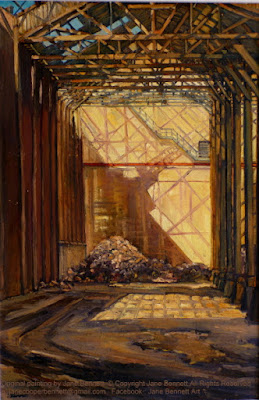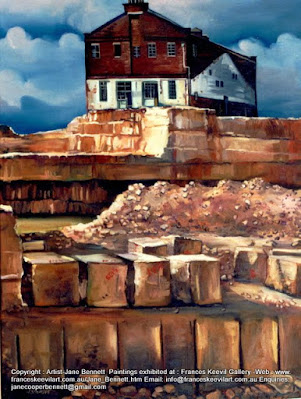
Starting my painting of
E136 'The Green Room,Heritage Store, North Eveleigh'
2017 oil on canvas 36 x 46cm
Available
Even though Eveleigh Carriage Workshops closed during the 1980s, a section of the Paint Shop remains in railway use today.

Starting my painting of
E136 'The Green Room,Heritage Store,
North Eveleigh'
2017 oil on canvas 36 x 46cm
Available
The Paint Shop is owned by RailCorp and used by the Office of Rail Heritage to store heritage rolling stock and moveable relic collections. It is the storage site of the heritage suburban electric fleet which are being painstakingly restored by the dedicated volunteers of Historic Electric Traction.

Starting my painting of
E136 'The Green Room -
Heritage Store, North Eveleigh'
2017 oil on canvas 36 x 46cm
Available
Many companies have tried to lay claim to the huge slice of no man's land west of Redfern Station, and it really does have a slightly besieged air.
The University of Sydney made a spirited attempt to add it to its empire and it was even recently touted as a potential home for Google's new Sydney headquarters before the NSW State Government poured cold water on the idea.
The latest candidate seems to be Atlassian, as the jewel in the crown of yet another proposed technology hub (don't governments love 'hubs'!)
I don't know what the difference is between a 'hub' and the more lowly category of mere 'business park', but I'm sure it would be several hundred million dollars at the least.
I know that some sort of redevelopment is inevitable, but how much of the heritage would be retained is still unclear.

Starting my painting of
E136 'The Green Room ,
Heritage Store, North Eveleigh'
2017 oil on canvas 36 x 46cm
Available
The doorway under the stairs once led to the Store itself, where an old storeman once doled out supplies.
This corner of the Paint Store is painted a brilliant and venomous shade of green. Green now has vague connotations of health and nature, but a hundred or so years ago, it had a different reputation.
This colour looks suspiciously like the notorious arsenic based 'Paris green' which was invented just after the Napoleonic Wars in the early 19th century. It was so toxic that ballgowns dyed with this bright and deadly pigment were reputed to kill their wearers if they stayed too long at the dance. Wallpaper painted with Paris Green was even supposed to have contributed to the final illness and death of Oscar Wilde.
As though the arsenic and copper ingredients of the original formula weren't sufficiently deadly, some warped genius later added lead arsenate to the cocktail.
As this building long predates any health and safety rules my suspicions could be well founded. If you could overlook its one lonely drawback of being horribly poisonous, 'Paris green' is a very useful paint - bright, fairly stable, very opaque and giving good coverage. It has been used to colour fireworks, and also to kill rats in the Parisian sewers; hence its name. And it kills mosquitoes quickly and effectively. What's not to love about a paint like that......
In the theatre, a 'green room' is a waiting room for performers before, during and after the performance.
I feel that this quiet and neglected corner of inner Sydney will soon be the venue for a spectacular drama starring government, developers, community groups, universities and fabulously wealthy and powerful international companies.
There will probably be fireworks.
And it could well become toxic.









